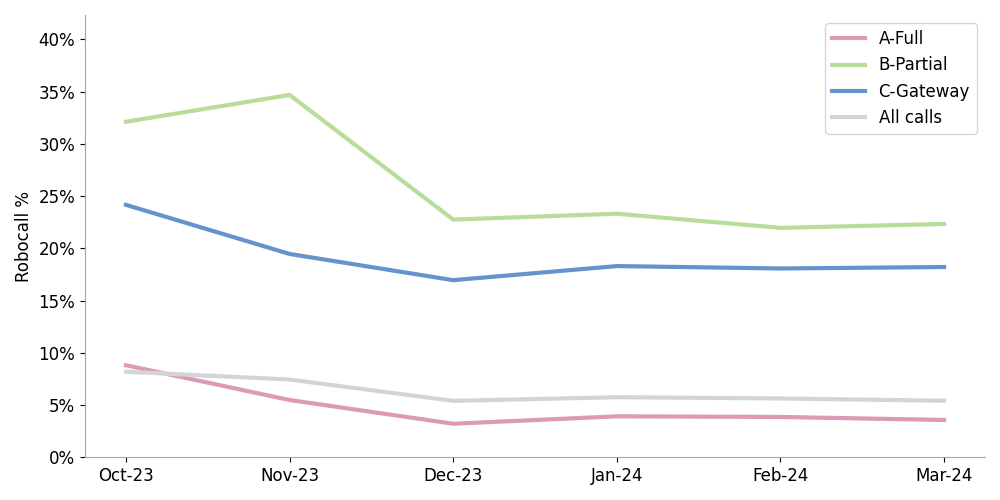STIR/SHAKEN statistics from March 2024
The March 2024 STIR/SHAKEN and robocall statistics are now available. The data show the latest trends in robocalls, STIR/SHAKEN participation and attestation level usage.
We’ve been publishing monthly STIR/SHAKEN statistics since April 2021. These numbers are gathered from well over a hundred voice service providers using our STIR/SHAKEN and robocall prevention solutions. The data describe calls they received from 962 other voice service providers that originated calls, including some robocalls, signed with STIR/SHAKEN.
Many robocalls are signed with B or C attestation
Robocalls unchanged across all attestation levels

Figure 1. Signed Robocalls by Attestation Last 6 Months
Figure 1 shows robocalls by attestation level over the past six months. Robocalls were unchanged across all attestation levels.
STIR/SHAKEN participation and coverage
We measure STIR/SHAKEN participation changes in two ways:
- The number of Originating Service Providers (OSPs) signing calls received by our customers,
- Service providers authorized to do SHAKEN by the STI Policy Administrator (STI-PA),
SHAKEN signing up slightly

Figure 2. Monthly Number of OSPs Sending Signed Calls
Figure 2 shows the number of Originating Service Providers (OSPs) signing calls. We saw 26 new SHAKEN signers in March, a 2.8% increase.
The number of SHAKEN-authorized providers up slightly

Figure 3. STIR/SHAKEN Authorized Providers by Month
Figure 3 shows the number of SHAKEN authorized providers. There were 33 additional SHAKEN-authorized providers in March, a 2.6% increase.
These two measures show that the STIR/SHAKEN participation increased slightly.
STIR/SHAKEN coverage
Signed calls at termination level

Figure 4. The Percentage of Signed Calls at Termination Last 6 Months
Figure 4 shows the percentage of signed calls at termination for the past six months. This statistic was 37.0% in March, down slightly from 34.7% in February.
This level of coverage is still too low for effective use of call attestation information by terminating providers. The primary reason for low STIR/SHAKEN coverage is widespread non-IP interconnections across the telephone network.
Calls with full attestation level

Figure 5. Percentage of Calls with SHAKEN Attestation Levels Last 6 Months
Figure 5 shows the percentage of calls signed by attestation level. Calls signed with full A-level attestation were 26.51% in March, down slightly from 26.86% in February. The change is so small, we’ll call it level.

Patterns among prolific robocall signers
Here are robocall and attestation statistics for the top 10 SHAKEN-authorized providers ranked by the percentages of signed calls identified as robocalls.
Prolific robocall signers send many robocalls with A- and B-level attestation

Figure 6. Robocall Percentage by Attestation—Prolific Robocall Signers by Robocall %
Figure 6 shows robocalls authenticated by prolific robocall signers over the past six months. In March, these robocall percentages were up 1.74% for calls signed with A-level attestation, down 6.04% for calls signed with B-level attestation, and down 3.82% for calls signed with C-level attestation.
We believe that terminating providers should evaluate the reputation of STIR/SHAKEN signers and use it as input to call validation treatment.
Recap
- Overall robocalls were level.
- SHAKEN participation increased slightly.
- SHAKEN coverage was level.
- The percentages of robocalls signed by the top 10 prolific robocall signers were up 1.74% for A-level calls, down 6.04% for B-level calls, and down 3.82% for C-level calls.
TransNexus solutions
TransNexus is a leader in developing innovative software to manage and protect telecommunications networks. The company has over 25 years’ experience in providing telecom software solutions including branded calling, toll fraud prevention, robocall mitigation and prevention, TDoS prevention, analytics, routing, billing support, STIR/SHAKEN and SHAKEN certificate services.
Contact us today to learn more.
Our STIR/SHAKEN products:
- Work with your existing network
- Support SIP and TDM
- Affordable, easy to deploy